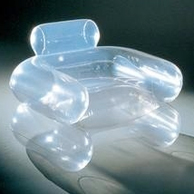Blow - Zanotta
inflatable chair (1967)
The Blow inflatable armchair, 1967, is a project by Jonathan De Pas, Donato D'Urbino, Paolo Lomazzi with Carla Scolari, made by Zanotta in PVC ©.
The designers, after the success at the Salone del Mobile '68, created other inflatable and visionary objects in transparent PVC, such as the pneumatic pavilion at the 2nd Eurodomus in Turin.
Blow is the first example of Italian "pneumatic design", the image of a new free and light style. It is the closest creation to the idea of Marcel Breuer's utopian project of a piece of furniture "supported by a column of air"... In addition to the confirmation of how Zanotta works over time on the research and promotion of experimental products for an advanced audience.
The Blow armchair was also designed as a low-cost "for travel" furniture item, easy to transport and assemble.
Blow is among the cult objects that have made the history of design and Made in Italy. Like numerous other products created in the 1960s, it anticipates trends and lifestyles, becoming an icon of international design and a timeless object.
Although the Blow armchair is now out of production, it is considered an iconic object of Pop design, a symbol of the "mythical Sixties", a representation of the spirit of provocation and disruption and of the socio-cultural changes of those years.
Unmistakable thanks to its soft and transparent shapes, innovative in the use of materials and technology never before applied in the furniture sector, precursor of democratic and mass design.
Made of PVC, it is built in molds for the processing of plastic materials, composed of the welding of different parts and then inflated with air.
Produced in different colours, it was equipped with a foot pump bellows which was placed in a suitcase. Perfect as an outdoor or pool chair, but can be used anywhere according to needs.
Blow is part of several collections and museums including:
MoMA - Museum of Modern Art
Museum für Gestaltung Zürich, Design Collection
Vitra Design Museum









